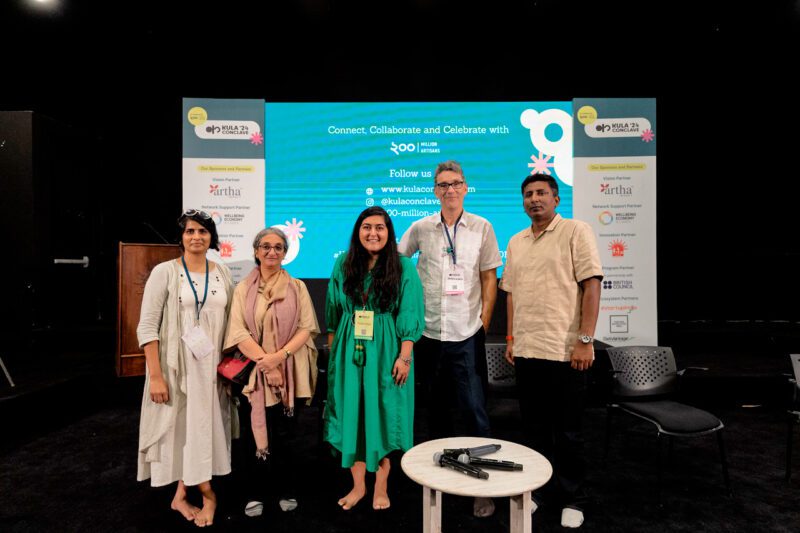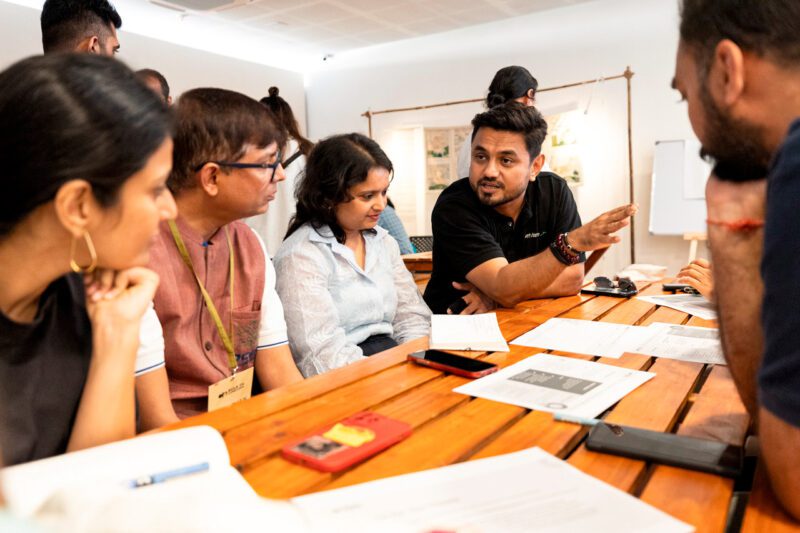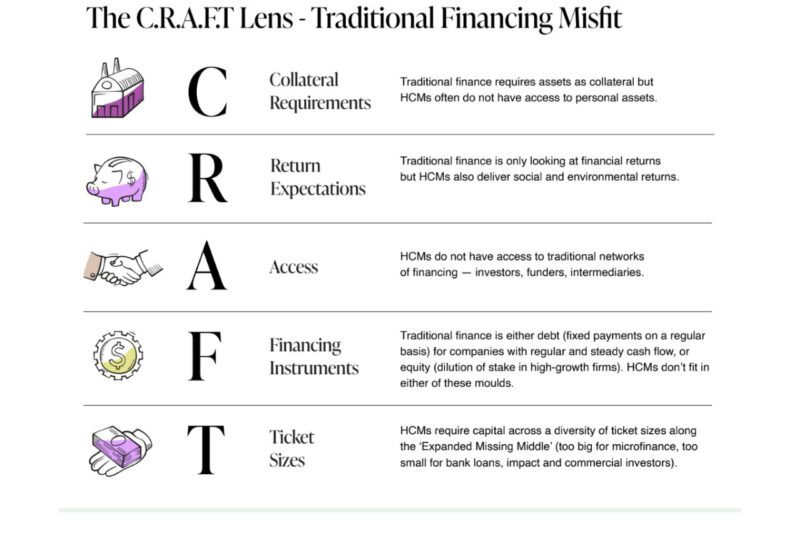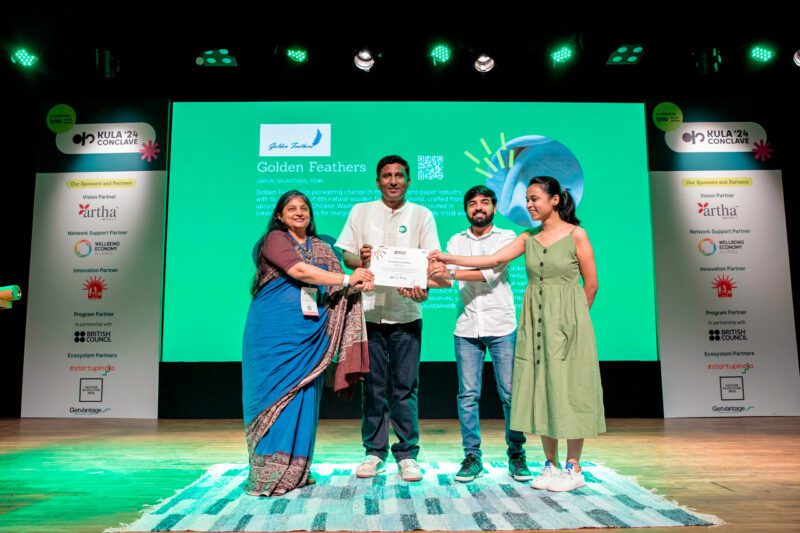Unplastifying the Future
Tati Besada’s mission to restore our oceans
Thinking in systems

What If the Future of Innovation is Handmade?
Craft and climate. Innovation and informality. Creativity and capital. These terms rarely sit side by side in entrepreneurial discourse, let alone in startup or impact investing circles. Yet across India — and increasingly, the Global South — a quiet revolution anchored in creativity, culture, craft, and community is brewing. It’s not unicorns or “soonicorns” leading this charge, but an ambitious cohort of purpose-driven enterprises, mostly women-led, redefining how we create, consume, and connect. They are innovating despite limited infrastructure, and often because of it.
As collaborators in Kula Conclave 2024 and Kula Innovate 2024, we’ve witnessed first-hand a new cohort of craft-led, micro, small, and medium-sized enterprises (MSMEs) building climate-smart, community-focused solutions within India’s Creative Manufacturing and Handmade (CMH) sector — a massive subset of the nation’s $2 trillion cultural economy.
The work of these enterprises challenges deep assumptions about what innovation looks like — and more importantly, who it should serve. Yet, they remain largely invisible to traditional capital ecosystems and by default to the mainstream economic, policy, and investment narratives. If we are to harness their full potential for climate, gender, and inclusive growth goals, it is time we rethink how we articulate, finance, and support innovation-led craft futures.

Speakers from Canopy, Brown Living, Kadam Haat, British Council, and Golden Feathers as part of a session on Catalysing Pro-Climate Innovations; From Materials to Value Chains at Kula 2024
India’s Creative Manufacturing and Handmade ecosystem is a largely untapped engine for climate-positive solutions — spanning fashion, textiles, home décor, e-commerce, craft-tech, luxury and design, value-added agri-products, and more. These craft-led MSMEs preserve traditional knowledge, empower women, sustain over 200 million livelihoods, and build climate-resilient futures, often in the country’s most vulnerable regions.
Unlike tech startups that often scale through centralized servers and code, these enterprises thrive in culturally rooted, family-centred, and distributed production networks. Their ‘New Formal’ models are inherently decentralized — not as a liability, but as an adaptive advantage. In such settings, access to ergonomic tools, bamboo or loom machinery, and digital design platforms can vastly improve productivity, health outcomes, and storytelling potential — especially when supported by local innovation infrastructure.

Investors for Investors Workshop at Kula 2024
Take Xuta, a yarn bank initiative on Assam’s Majuli island, where over 150 women artisans balance farming, caregiving, and seasonal weaving. Xuta brings work home to them, providing formal inclusion via finance, loom maintenance, and training, even as the region lacks basic infrastructure like electricity, digital tools, and reliable logistics. As Xuta’s co-founder Rishi Sarmah notes, “A person in Delhi can export cheaply because the airport is right there. We send it from the village to Imphal, then Guwahati, then Delhi.”
Innovation-led, craft futures can no longer be termed niche, charity-driven or unscalable.
Enterprises like Xuta are innovating despite these challenges and are eager to scale. But their seasonal production cycles, community-based operations, and non-linear growth trajectories don’t fit typical startup or investment models. Their biggest need is access to the right capital and financial instruments tailored to their regional realities.
Data from Business of Handmade – 2nd Edition reveals that while 92% of craft-led enterprises see catalytic capital as a great fit for their needs, only 1 in 10 report easy access to finance. Why? Because craft-led enterprises need multiple forms of capital — startup funds for new collectives, working capital to bridge production cycles, growth capital for scaling innovation, and long-term R&D capital to reimagine processes and materials. Few capital providers offer this spectrum. The diversity of models — from cooperatives to social enterprises to for-profit hybrids — demands flexible, tailored capital pathways. Yet, current systems treat them as anomalies, not archetypes.

Rishi Sarmah of Xuta wins the Kula Innovate Award
The diversity of models demands diversity in capital access:
Entrepreneurs like those behind Ecokaari, Studio Coppre, Golden Feathers, Xuta, and Resham Sutra — winners at Kula Innovate 2024 Challenge — are among the many pioneering solutions across craft-based value chains. Yet, 80% of craft-led MSMEs in India continue to face an innovation capital gap; they often bootstrap their innovations using working capital rather than dedicated R&D funds which most formal, recognized sectors account for. This is a failure of fit and of intention, not the lack of ambition.

From Business of Handmade – 2nd Edition | Financing a Handmade Revolution (2023) by 200 Million Artisans; HCMs refer to Handmade and Craft-led MSMEs.
This misfit is not just financial. It is also cultural, temporal, and infrastructural. The innovation needs of Resham Sutra or Golden Feathers differ vastly from those of Xuta. Yet capital systems continue to apply ‘one-size-fits-all’ expectations of scale, exits, and pitch-decks to a culturally diverse, multilingual, and decentralized ecosystem.
Closing the innovation-capital gap for craft-led enterprises requires us to think—and act—in systems.
The demand for capital is not the problem. We lack the supply of ‘creative’ fit-for-purpose capital that not only accepts disproportionate risk, generates positive impact, but also acts as a bridge for mainstream, third-party investment to jump in. We see catalytic capital as the key that can unlock the potential of nascent but growing sectors like the Creative Manufacturing and Handmade.

The Golden Feathers team wins the Kula Innovate Award
At Kula Innovate 2024, we tested new models with promising results. Innovation Award winners received not just innovation grants, but patient debt, gap financing, and clean energy assets. SELCO Foundation offered more than checks — they engaged in design, mentorship, and strategic matchmaking. As did other partners like Artha Impact (Rianta Capital, Zurich) and Catalyst AIC, an India-based accelerator. Here’s what we’re learning:

SELCO Foundation – Ecosystem approach, IRENA, 2022
Institutional Capacity Building Matters: Future-ready backward linkages accelerate enterprise growth. Thus, investment in capacity building — such as strengthening craft-based SHGs, cooperatives, and rural producer companies by integrating creative entrepreneurship – design, digital literacy, product strategy, and marketing – into local education and skill development programs — is critical for holistic development of the ecosystem.
Innovation-led, craft futures can no longer be termed niche, charity-driven or unscalable. Craft-led enterprises are already building global brands, integrating technologies, and delivering returns. Platforms like Kula Conclave and Kula Innovate are not just conveners — they are translators between the language of investment and the lived realities of craft-led enterprises.
Now is the time to invest in scalable, co-created infrastructure — financial, physical, and digital — that meets the many creative, cultural, and craft-led enterprises where they are and grows with them. To build the scaffolding for an enabling environment for creative manufacturing, organizations need to become systems integrators — weaving together finance, technology, training, storytelling, infrastructure, and fair-market ecosystems in ways that suit local contexts. For example, the SELCO Foundation is deploying “common good infrastructure” — such as solar-powered production centers — to finance the conditions of innovation, not just the innovators.
The next leap in climate innovation may not be written in code, but woven in yarn, powered by the sun, and shaped by women from far-flung lands. The stories from Kula Innovate and the broader research is clear: innovation is happening. The real question is whether capital systems will catch up — or get left behind.
—
For more insights and to join the conversation, visit www.kulaconclave.com. *Kula, in different local Indian languages has many meanings: community, kinship, family, like-mindedness.
Check out the winning innovators of Kula Innovate 2024, an sector-first innovation challenge designed to close the R&D gaps across craft-value chains.
Related Content
Comments
Deep Dives

Featuring
Clarisse Awamengwi
IE Correspondent
July 17 - 12:00 PM EST

Featuring
Russell McLeod
July 24 - 12:00 PM EST
RECENT
Editor's Picks
Webinars
News & Events
Subscribe to our newsletter to receive updates about new Magazine content and upcoming webinars, deep dives, and events.
Become a Premium Member to access the full library of webinars and deep dives, exclusive membership portal, member directory, message board, and curated live chats.
At Impact Entrepreneur, we champion fearless, independent journalism and education, spotlighting the inspiring changemakers building the Impact Economy. Diversity, equity, sustainability, and democracy face unprecedented threats from misinformation, powerful interests, and systemic inequities.
We believe a sustainable and equitable future is possible—but we can't achieve it without your help. Our independent voice depends entirely on support from changemakers like you.
Please step up today. Your donation—no matter the size—ensures we continue delivering impactful journalism and education that push boundaries and hold power accountable.
Join us in protecting what truly matters. It only takes a minute to make a real difference.
0 Comments